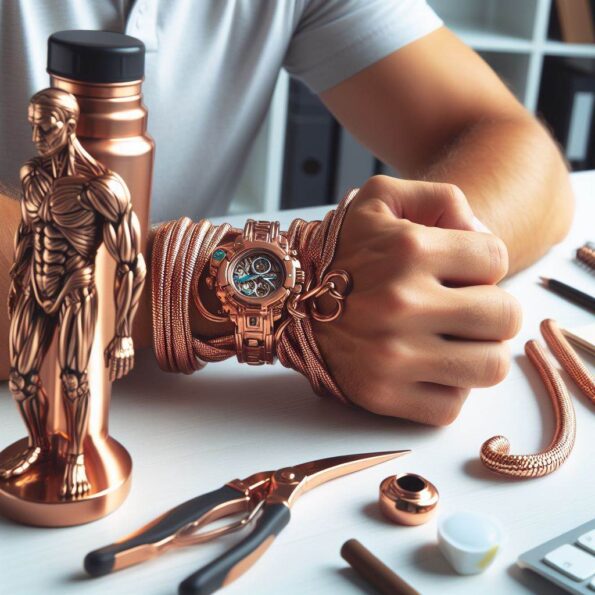Copper bracelets have been adorned for centuries, not only as a fashion statement but also for their purported health benefits. Their popularity has endured over time, with many people wearing them to add a touch of elegance and style to their outfits. Historically, copper has been valued for its natural properties, with civilizations such as the ancient Egyptians and Greeks believing in its healing powers.
The debate on the health benefits of copper bracelets, particularly for arthritis, is ongoing. While some users report reduced pain and stiffness in the joints, better joint flexibility, and overall improved health, the scientific community remains divided. Studies have shown mixed results, with some indicating no clinical impact and others suggesting a placebo effect or potential anti-inflammatory properties. Despite the lack of conclusive scientific evidence, the enduring popularity of copper bracelets speaks to the personal value many individuals find in wearing them.
Historical Significance of Copper in Medicine
Copper’s role in medicine is as ancient as it is profound. From the Smith Papyrus of ancient Egypt, circa 2400 B.C., which mentions copper as a sterilization agent for drinking water and wounds, to the Ayurvedic practices of India, where copper was revered for its antibacterial qualities and its supposed ability to balance the body’s biological energy, copper has been a constant in the healing traditions of many cultures.
The transition from folklore to modern perspectives on copper in medicine has been marked by a deeper understanding of its biochemical roles. Today, we recognize copper as an essential trace element involved in numerous body functions and regulatory pathways. While the ancients may have used copper based on empirical observations, modern science has elucidated its necessity for growth, development, and overall health. However, maintaining adequate copper levels is crucial, as both deficiency and excess can lead to health problems.
The journey of copper from a mystical healing element to a medically recognized mineral reflects the evolution of our understanding of health and medicine. It underscores the importance of integrating traditional knowledge with scientific inquiry to advance our approach to healing and wellness.
The Claims of Health Benefits
Copper bracelets are often touted for a variety of health benefits. Common claims include:
- Relief from arthritis pain: This is one of the most widely recognized claims, suggesting that copper bracelets can alleviate the pain and inflammation associated with arthritis.
- Improved blood circulation: Copper is believed to help improve blood circulation in the body.
- Toxin removal: Some believe that copper bracelets can help detoxify the body.
- Less inflammation: The dilation of blood vessels due to copper’s presence is thought to reduce inflammation.
- More energy: Wearing copper bracelets is sometimes associated with increased vitality.
- Faster recovery and healing: There is a belief that copper can speed up the healing process.
The theories behind how copper may influence health are based on its role as an essential trace mineral. It’s involved in making red blood cells, maintaining nerve cells, and supporting the immune system. Copper also helps the body form collagen and absorb iron, contributing to energy production. One theory suggests that copper may increase oxygenation of the blood, thereby improving its ability to carry oxygen molecules. It may also reduce inflammation throughout the body, which can improve circulation by reducing stress on blood vessels.
However, it’s important to note that while these claims are widespread, scientific evidence supporting the health benefits of copper bracelets is limited. Research has often found these claims to be partly or completely unsupported by clinical data. For instance, a study mentioned in Medical News Today found no improvement in arthritis symptoms from wearing copper bracelets. Therefore, while many people believe in the benefits of copper bracelets, they should not be considered a substitute for medical treatment.
Placebo Effect and User Testimonials
The placebo effect plays a significant role in the perceived effectiveness of copper bracelets. It refers to a beneficial effect, produced by a placebo drug or treatment, that cannot be attributed to the properties of the placebo itself, and must therefore be due to the patient’s belief in that treatment.
In the context of copper bracelets, even though there is no strong scientific evidence supporting their efficacy in treating conditions like arthritis, many users report positive outcomes. These testimonials are often attributed to the placebo effect, where the belief in the bracelet’s healing power can lead to a perception of pain relief and improved well-being.
User testimonials can be powerful because personal experiences and stories can influence others’ beliefs and decisions. However, it’s important to approach such testimonials with a critical mind, especially when they are not backed by scientific research. While the placebo effect can be real and impactful, it is not a substitute for evidence-based medical treatments.
Potential Risks and Considerations
When considering copper bracelets for health purposes, it’s important to be aware of potential side effects and contraindications:
- Skin Irritation: Copper can cause skin irritation and discoloration due to reactions with the skin’s natural oils and moisture.
- Allergic Reactions: Some individuals may experience allergic reactions to copper, resulting in itching, redness, or rashes.
- Copper Toxicity: Although rare, excessive absorption of copper can lead to toxicity, with symptoms like nausea, headaches, and joint pain.
- Mineral Imbalance: An increased amount of copper in the bloodstream could lead to an imbalance with other minerals in the body.
As for the regulatory stance, copper bracelets are generally not recognized by health authorities as medical devices with therapeutic benefits. Research, including a randomized double-blind placebo-controlled crossover trial, has found that wearing copper bracelets does not have any meaningful therapeutic effect beyond that of a placebo for conditions like rheumatoid arthritis. Therefore, they are not regulated as health devices but are often sold as alternative or complementary health products.

Alternatives to Copper Bracelets
For managing symptoms commonly associated with copper bracelet claims, such as arthritis pain, health professionals recommend a variety of evidence-based treatments. These include:
- Physical Activity and Exercise: Regular exercise can help reduce joint pain and stiffness, improve flexibility and muscle strength, and boost overall well-being.
- Hot and Cold Therapy: Applying heat or cold to affected joints can relieve pain and reduce inflammation.
- Over-the-Counter Medications: Non-steroidal anti-inflammatory drugs (NSAIDs) like ibuprofen can help manage pain and inflammation.
- Corticosteroids: These can be prescribed for short-term pain relief in inflammatory conditions.
- Disease-Modifying Antirheumatic Drugs (DMARDs): For rheumatoid arthritis, DMARDs can slow disease progression and preserve joint function.
- Weight Management: Maintaining a healthy weight can reduce stress on joints, particularly the knees and hips.
- Orthotics: Devices like braces or shoe inserts can provide support and relieve stress on joints.
- Psychological and Social Interventions: Stress-reduction techniques and cognitive-behavioral therapy can help manage the psychological aspects of chronic pain.
What is the best exercise for arthritis?
The best exercises for arthritis are those that are low-impact and help to improve joint flexibility and strength without causing further stress. Health professionals often recommend:
- Walking: It’s gentle on the joints and can be done almost anywhere.
- Swimming and Water Aerobics: The buoyancy of water supports body weight, reducing stress on the joints.
- Cycling: Either stationary or on a regular bike, it’s good for joint mobility and cardiovascular health.
- Tai Chi and Yoga: These exercises increase flexibility, balance, and strength, and also reduce stress.
- Strength Training: Helps to build muscle around the joints, which can protect them and improve function.
It’s important to start with mild, low-intensity exercises and gradually increase the intensity as your comfort level improves. Always consult with a healthcare provider before starting a new exercise regimen, especially if you have arthritis or other health conditions.
Conclusion
In conclusion, the journey through the history and claims surrounding copper bracelets highlights a complex interplay between belief and scientific evidence. While copper has been revered for its medicinal properties since ancient times, modern scientific scrutiny has not found substantial evidence to support many of the health claims made by proponents of copper bracelets.
The allure of copper bracelets persists, perhaps due to the placebo effect or the human tendency to trust in anecdotal experiences. However, when it comes to health and wellness, it is crucial to balance personal beliefs with empirical evidence. While copper bracelets are generally safe to wear, they should not replace conventional medical treatments advised by healthcare professionals.
Ultimately, the best approach to managing health conditions like arthritis involves a combination of lifestyle changes, medical interventions, and, if desired, complementary therapies—each chosen with careful consideration of the individual’s unique circumstances and in consultation with healthcare providers. In conclusion, incorporating copper bracelets into your daily routine can offer various health benefits, from reducing inflammation to boosting overall well-being. Discover more about the benefits of copper products at The Amrit Life.











